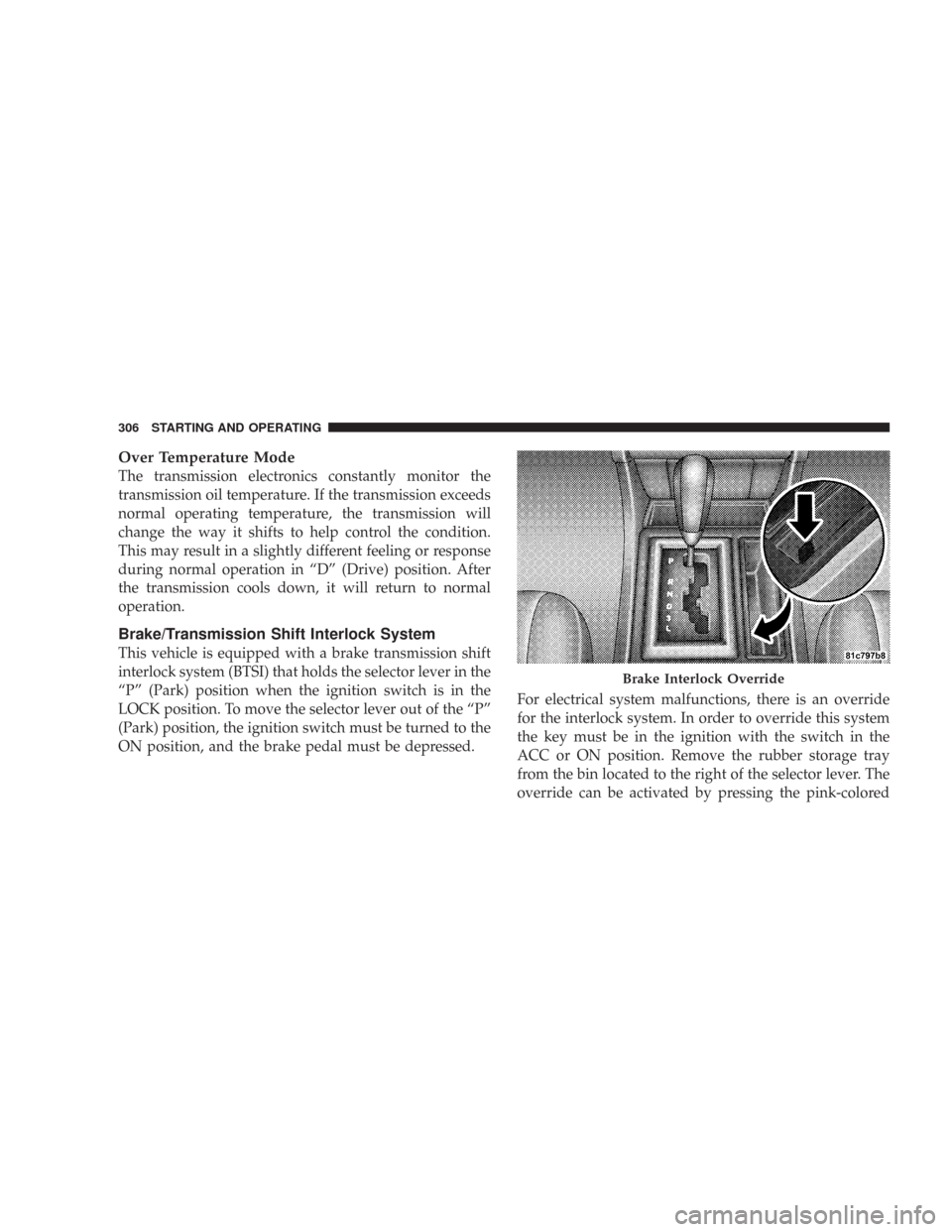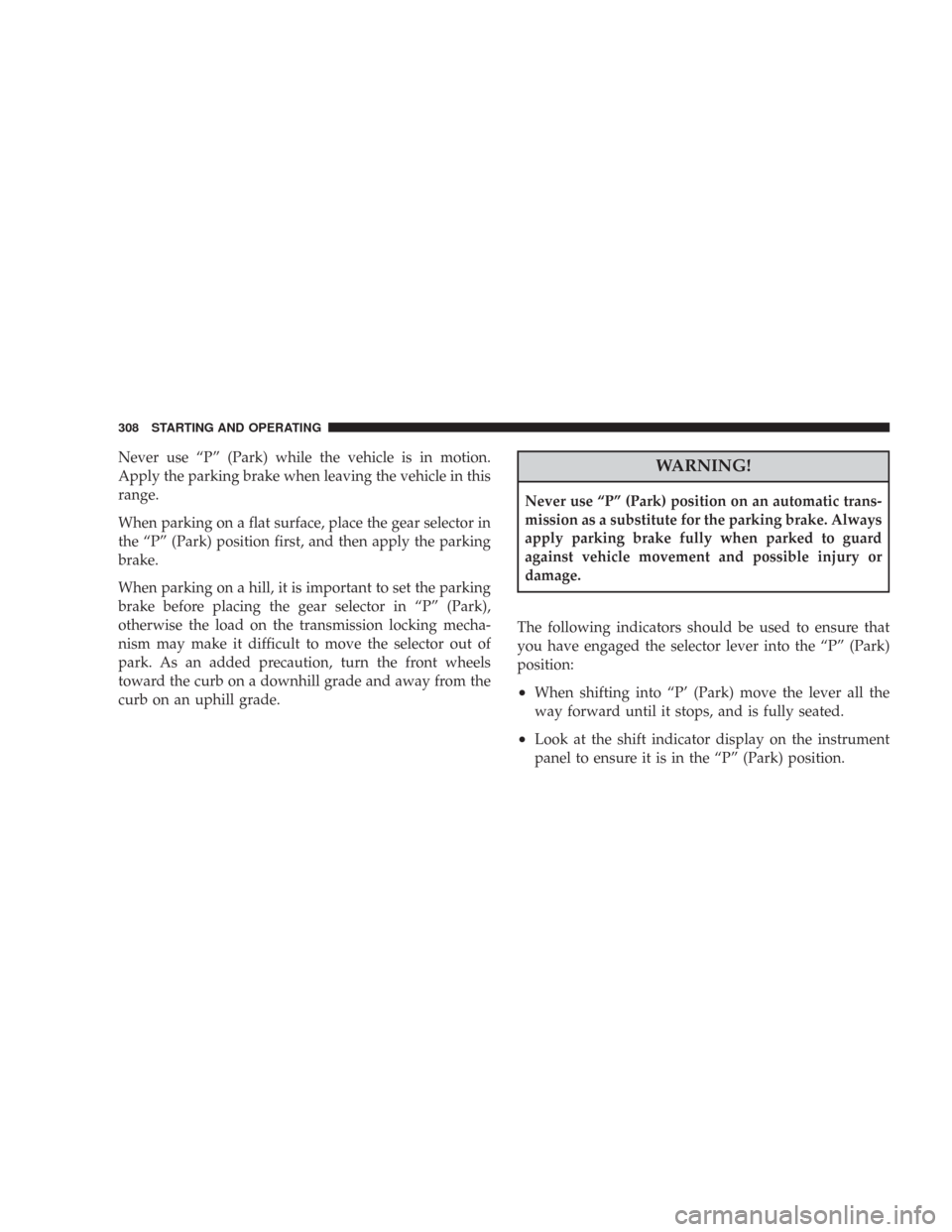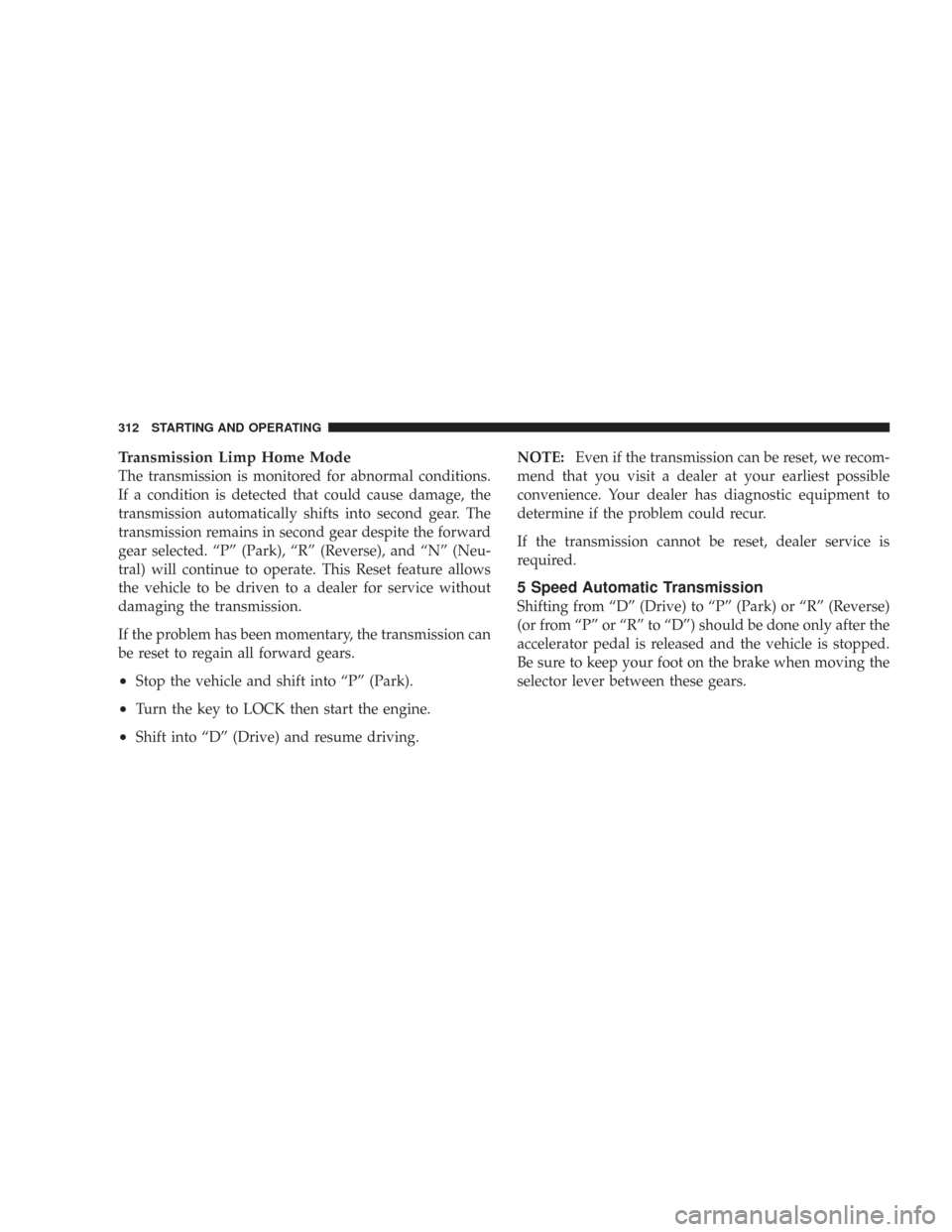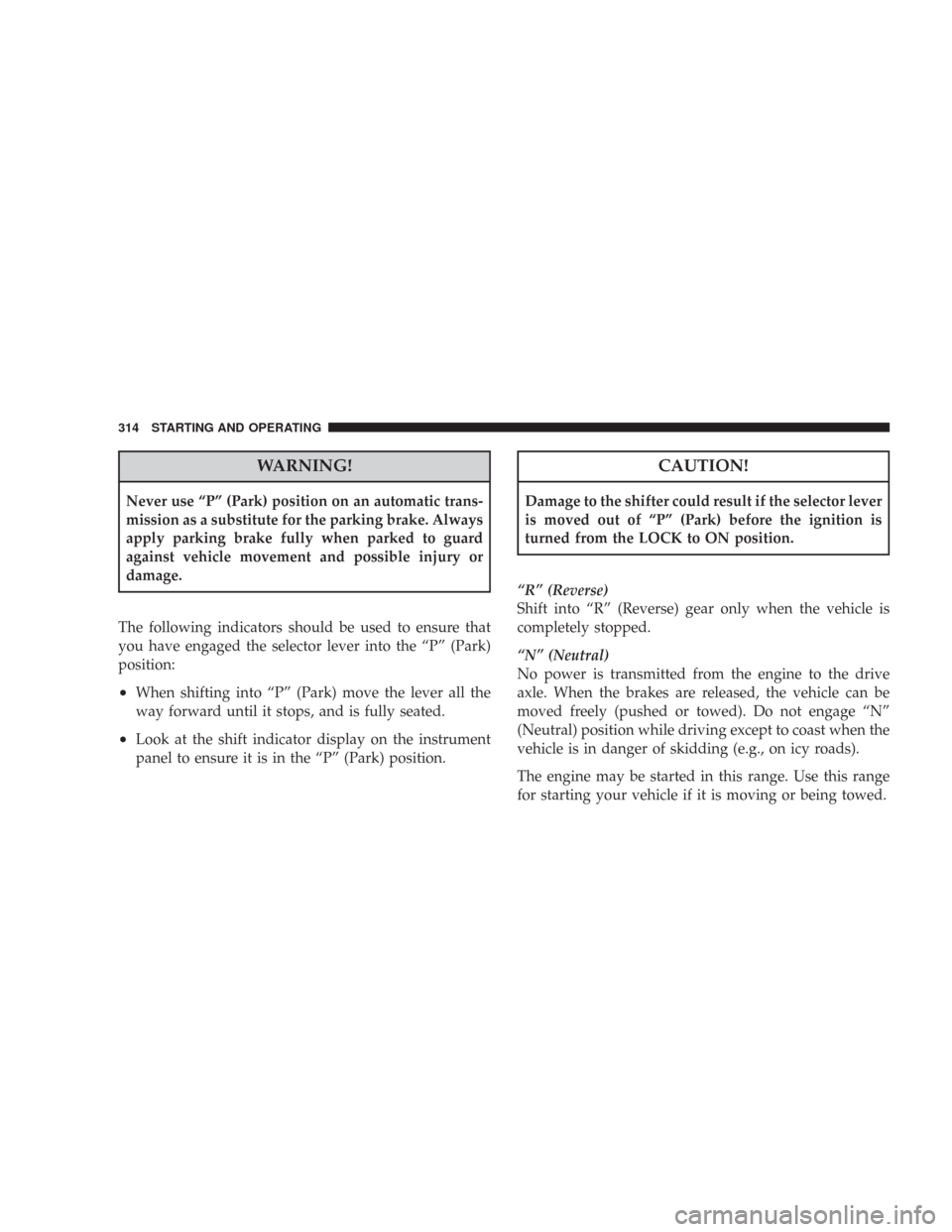Page 306 of 519

Over Temperature Mode
The transmission electronics constantly monitor the
transmission oil temperature. If the transmission exceeds
normal operating temperature, the transmission will
change the way it shifts to help control the condition.
This may result in a slightly different feeling or response
during normal operation in “D” (Drive) position. After
the transmission cools down, it will return to normal
operation.
Brake/Transmission Shift Interlock System
This vehicle is equipped with a brake transmission shift
interlock system (BTSI) that holds the selector lever in the
“P” (Park) position when the ignition switch is in the
LOCK position. To move the selector lever out of the “P”
(Park) position, the ignition switch must be turned to the
ON position, and the brake pedal must be depressed.For electrical system malfunctions, there is an override
for the interlock system. In order to override this system
the key must be in the ignition with the switch in the
ACC or ON position. Remove the rubber storage tray
from the bin located to the right of the selector lever. The
override can be activated by pressing the pink-colored
Brake Interlock Override
306 STARTING AND OPERATING
Page 307 of 519
tab, which can be accessed through a hole inside the bin.
While the override is pressed, the shifter can be moved
out of the “P” (Park) position without pressing the brake.
After operation, return the rubber storage tray to its
original position.
4 Speed Automatic Transmission
Shifting from “D” (Drive) to “P” (Park) or “R” (Reverse)
(or from P or R to D) should be done only after the
accelerator pedal is released and the vehicle is stopped.
Be sure to keep your foot on the brake when moving the
selector lever between these gears.
Gear Ranges
“P” (Park)
“P” (Park) supplements the parking brake by locking the
transmission. The engine can be started in this range.
Selector Lever
STARTING AND OPERATING 307
5
Page 308 of 519

Never use “P” (Park) while the vehicle is in motion.
Apply the parking brake when leaving the vehicle in this
range.
When parking on a flat surface, place the gear selector in
the “P” (Park) position first, and then apply the parking
brake.
When parking on a hill, it is important to set the parking
brake before placing the gear selector in “P” (Park),
otherwise the load on the transmission locking mecha-
nism may make it difficult to move the selector out of
park. As an added precaution, turn the front wheels
toward the curb on a downhill grade and away from the
curb on an uphill grade.WARNING!
Never use “P” (Park) position on an automatic trans-
mission as a substitute for the parking brake. Always
apply parking brake fully when parked to guard
against vehicle movement and possible injury or
damage.
The following indicators should be used to ensure that
you have engaged the selector lever into the “P” (Park)
position:
•When shifting into “P’ (Park) move the lever all the
way forward until it stops, and is fully seated.
•Look at the shift indicator display on the instrument
panel to ensure it is in the “P” (Park) position.
308 STARTING AND OPERATING
Page 309 of 519
CAUTION!
Damage to the shifter could result if the selector lever
is moved out of “P” (Park) before the ignition is
turned from the LOCK to ON position.
“R” (Reverse)
For moving the vehicle rearward. Always stop before
moving the lever to “R” (Reverse), except when rocking
the vehicle.
“N” (Neutral)
Engine may be started in this range.
CAUTION!
Coasting the vehicle or driving for any other reason
with selector lever in NEUTRAL can result in trans-
mission damage.
WARNING!
Do not coast in “N” (Neutral) and never turn off the
ignition to coast down a hill. These are unsafe
practices that limit your response to changing traffic
or road conditions. You might lose control of the
vehicle and have an accident.
“D” (Overdrive)
This range should be used for most city and highway
driving. It provides the smoothest up shifts and down
STARTING AND OPERATING 309
5
Page 312 of 519

Transmission Limp Home Mode
The transmission is monitored for abnormal conditions.
If a condition is detected that could cause damage, the
transmission automatically shifts into second gear. The
transmission remains in second gear despite the forward
gear selected. “P” (Park), “R” (Reverse), and “N” (Neu-
tral) will continue to operate. This Reset feature allows
the vehicle to be driven to a dealer for service without
damaging the transmission.
If the problem has been momentary, the transmission can
be reset to regain all forward gears.
•Stop the vehicle and shift into “P” (Park).
•Turn the key to LOCK then start the engine.
•Shift into “D” (Drive) and resume driving.NOTE:Even if the transmission can be reset, we recom-
mend that you visit a dealer at your earliest possible
convenience. Your dealer has diagnostic equipment to
determine if the problem could recur.
If the transmission cannot be reset, dealer service is
required.
5 Speed Automatic Transmission
Shifting from “D” (Drive) to “P” (Park) or “R” (Reverse)
(or from “P” or “R” to “D”) should be done only after the
accelerator pedal is released and the vehicle is stopped.
Be sure to keep your foot on the brake when moving the
selector lever between these gears.
312 STARTING AND OPERATING
Page 313 of 519
Gear Ranges
“P” (Park)
“P” (Park) supplements the parking brake by locking the
transmission. The engine can be started in this range.Never use “P” (Park) while the vehicle is in motion.
Apply the parking brake when leaving the vehicle in this
range.
When parking on a flat surface, place the gear selector in
the “P” (Park) position first, and then apply the parking
brake.
When parking on a hill, it is important to set the parking
brake before placing the gear selector in “P” (Park),
otherwise the load on the transmission locking mecha-
nism may make it difficult to move the selector out of
park. As an added precaution, turn the front wheels
toward the curb on a downhill grade and away from the
curb on an uphill grade.
Selector Lever
STARTING AND OPERATING 313
5
Page 314 of 519

WARNING!
Never use “P” (Park) position on an automatic trans-
mission as a substitute for the parking brake. Always
apply parking brake fully when parked to guard
against vehicle movement and possible injury or
damage.
The following indicators should be used to ensure that
you have engaged the selector lever into the “P” (Park)
position:
•When shifting into “P” (Park) move the lever all the
way forward until it stops, and is fully seated.
•Look at the shift indicator display on the instrument
panel to ensure it is in the “P” (Park) position.
CAUTION!
Damage to the shifter could result if the selector lever
is moved out of “P” (Park) before the ignition is
turned from the LOCK to ON position.
“R” (Reverse)
Shift into “R” (Reverse) gear only when the vehicle is
completely stopped.
“N” (Neutral)
No power is transmitted from the engine to the drive
axle. When the brakes are released, the vehicle can be
moved freely (pushed or towed). Do not engage “N”
(Neutral) position while driving except to coast when the
vehicle is in danger of skidding (e.g., on icy roads).
The engine may be started in this range. Use this range
for starting your vehicle if it is moving or being towed.
314 STARTING AND OPERATING
Page 319 of 519

ALL WHEEL DRIVE — IF EQUIPPED
This feature provides full time All Wheel Drive (AWD)
with Anti-lock Brake System (ABS)/Traction Control.
The front wheels provide 38% of the torque, and the rear
wheels provide 62% of the torque. The system is auto-
matic with no driver inputs or additional driving skills
required.
CAUTION!
All wheels must have the same size and type tires.
Unequal tire sizes must not be used. Unequal tire
size may cause failure of the front differential and/or
the transfer case.
DRIVING ON SLIPPERY SURFACES
Acceleration
Rapid acceleration on snow covered, wet, or other slip-
pery surfaces may cause the rear wheels to pull errati-
cally to the right or left. This phenomenon occurs when
there is a difference in the surface traction under the rear
(driving) wheels.
WARNING!
Rapid acceleration on slippery surfaces is dangerous.
Unequal traction can cause sudden pulling of the rear
wheels. You could lose control of the vehicle and
possibly have an accident. Accelerate slowly and
carefully whenever there is likely to be poor traction
(ice, snow, wet mud, loose sand, etc.).
STARTING AND OPERATING 319
5